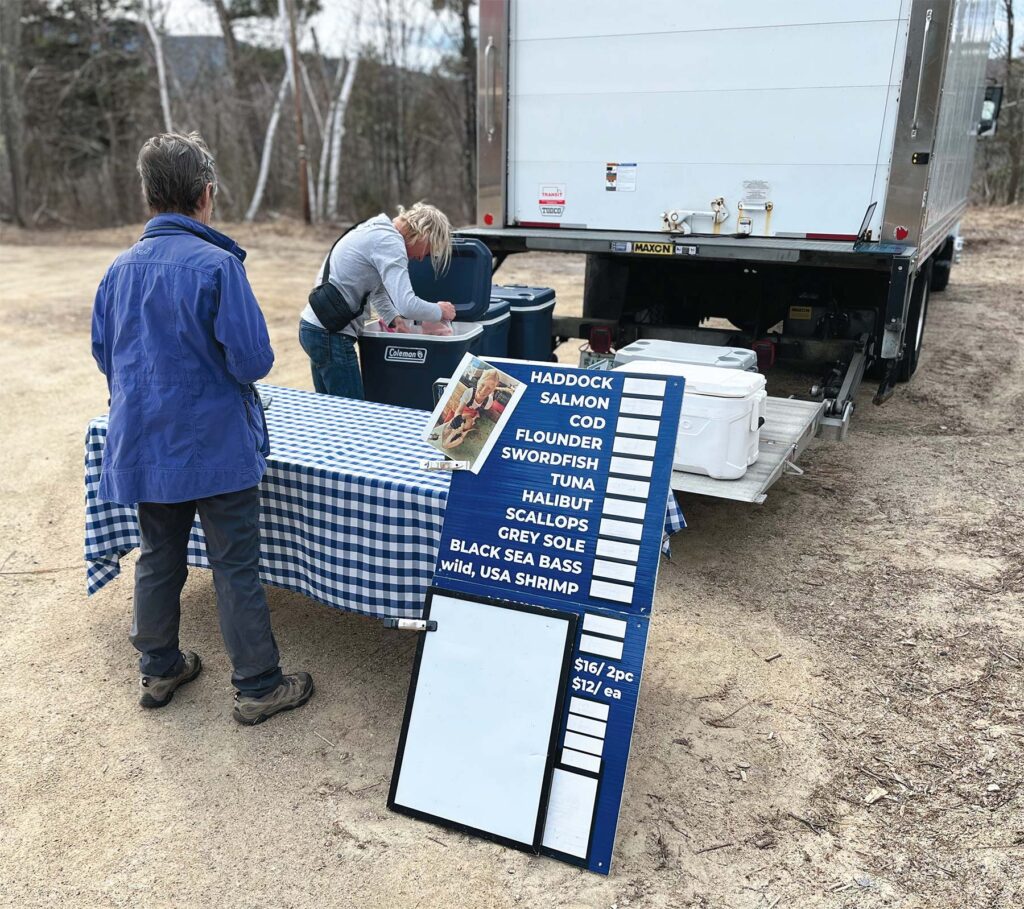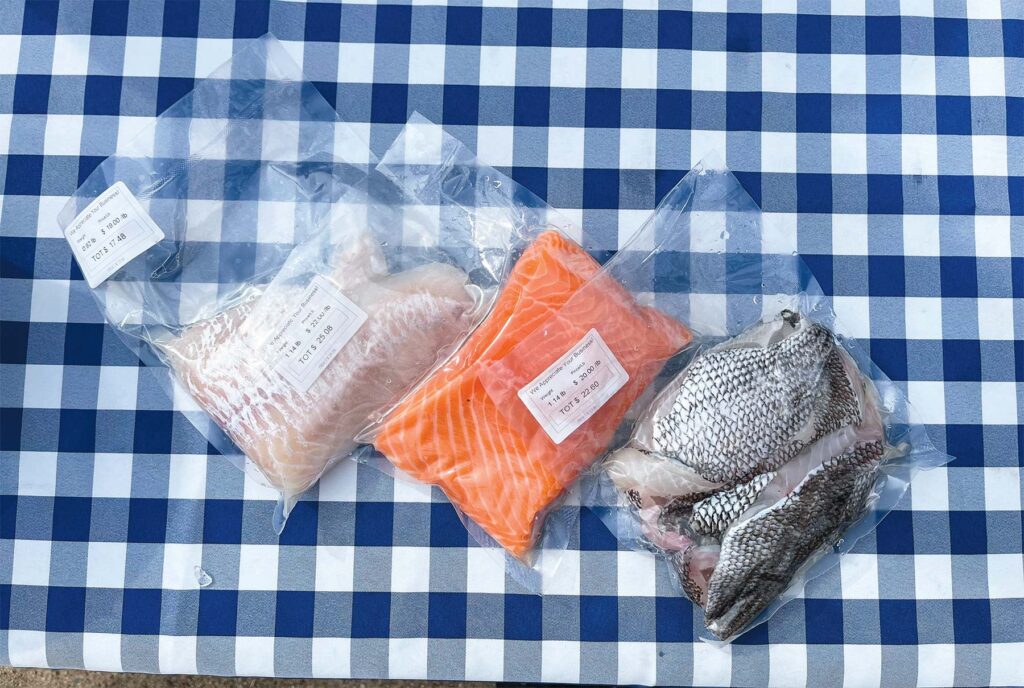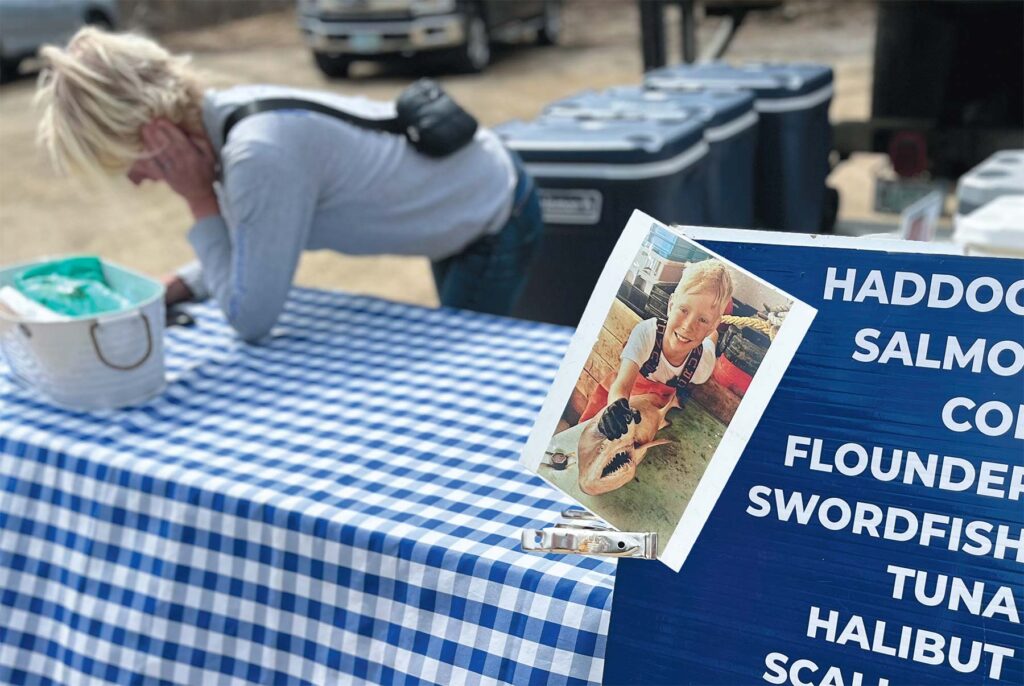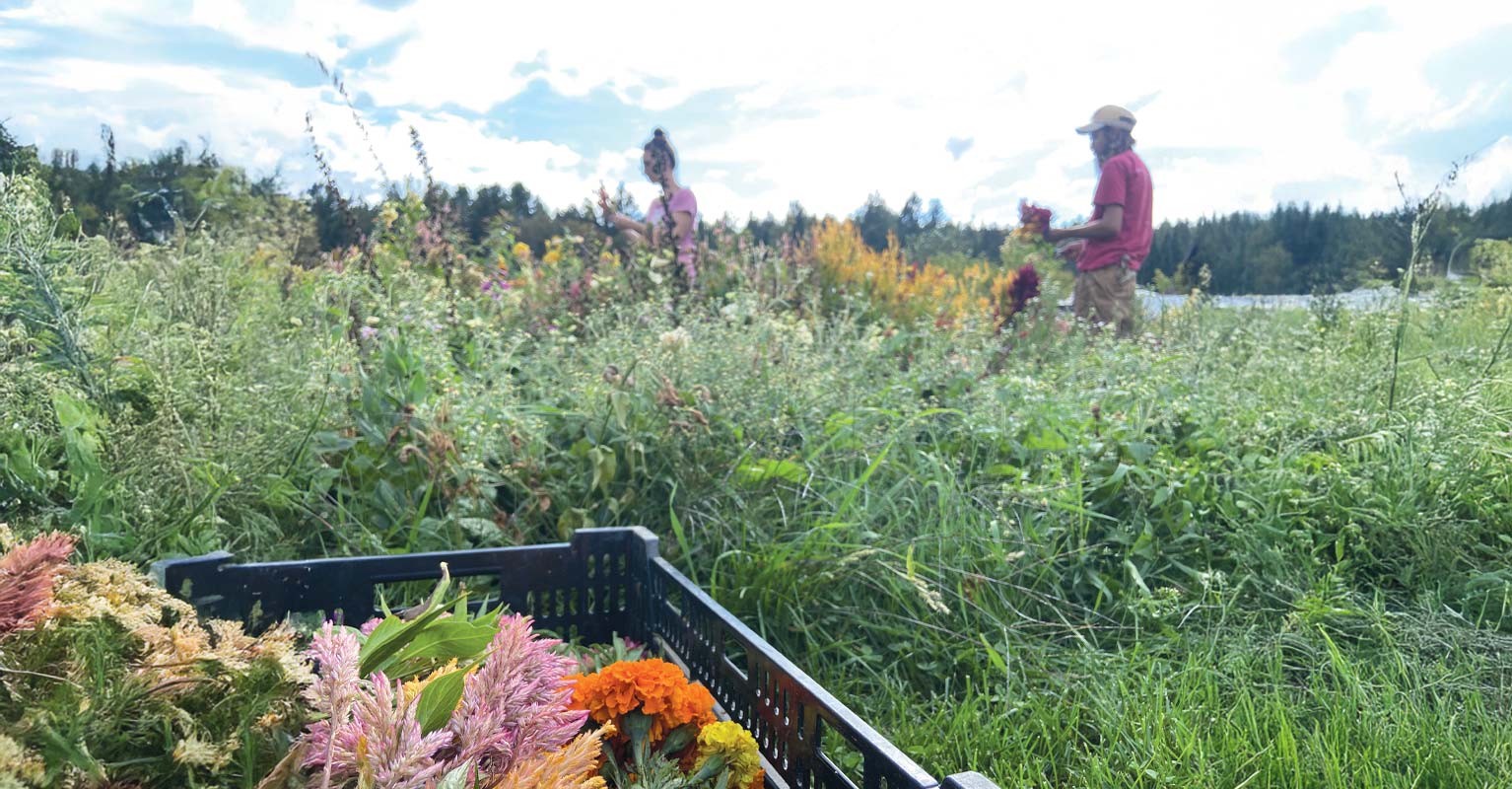Gaelyn Plachowicz, founder of the Boy’s Fresh Catch.
With a table and an armada of coolers staged beside her truck—in the parking lot behind the store, by a row of pine trees—Plachowicz greets her customers the same way you or I might say hello to a friend at the local coffee shop.
A COUPLE WINTERS AGO, I drove north from Boston to meet up with my friends Brianna and Sam for one of those White Mountain Saturdays that requires a big, gooey dinner at sundown. When we retired to their house in the hills of Jackson after a long quad-straining ski to Zealand Falls, my ears perked up as Sam announced that he’d be cooking some local scallops for our supper.
“Local?” I asked. “Aren’t you guys, like, an hour and a half from the coast?”
But my skepticism melted away when I popped one of those scallops—sautéed with white miso and mirin—into my gullet. The briny, buttery freshness of each mollusk was unmissable, and it was at this moment when Brianna revealed how our seafood made its way into the mountains. And like many good stories, it involved a journey.

FISHERMAN’S WIFE DRAWS A MAP…
Gaelyn Plachowicz grew up in New York, but when she met and married a New England scallop fisherman, a change of locale was set in motion. Initially the two put down roots in the Greater Boston area near the docks of Gloucester. But when kids entered the picture, the family relocated to the more affordable town of Wolfeboro. As she got the lay of the land through managing a restaurant and making regular expeditions to supermarkets and farmers’ markets, Plachowicz started to notice that fresh seafood was a scarce commodity in the Wolfeboro area.
“I was shocked by the low quality of the fish that I saw, given that we’re really not that far from Maine and Massachusetts,” Plachowicz says. “From talking with people I knew at our farmers’ market, I learned that a lot of folks would drive to Portsmouth or Gloucester, stock up on fish, and stick it all in their freezers.” Unwilling to shake the paradox of a fresh seafood deficit—in a neighboring region to the New England coast—Plachowicz dug deeper and asked her family’s friends in the seafood industry in Greater Boston how this could be. The problem, according to her inside sources, was finding economical shipping routes for the large seafood delivery truck.
“I heard all of this,” Plachowicz recalls with a knowing chuckle. “And I thought, ‘Well… I’ll do it.”
Being intimately versed in the mechanics of the commercial fishing business, Plachowicz was uniquely positioned to solve this puzzle. By 2011, a road map started to materialize. She would buy a refrigerated truck, negotiate a partnership with a local boat or two, and acquire a small bounty of seafood to drive back to the weekly Wolfeboro Farmers’ Market—where her customers could pick up their orders after placing them in advance. But Plachowicz’s fish would not be frozen. It would be washed, filleted, packaged “the moment it hits the docks,” and sold fresh.
“Over the first summer that I did this, the response from the customers was huge,” Plachowicz notes. “People were thrilled about not having to make a three-hour round trip just to buy some good haddock.” Each round of seafood pickups and enthusiastic feedback impressed something on Plachowicz—it wasn’t just the distance between New Hampshire towns and the ocean that created an obstacle to getting fresh seafood. Most of Plachowicz’s customers were from Wolfeboro, meaning that perceived distance between a town with fresh seafood and a town without it could also be a barrier. “I thought, ‘What if I took this on the road?’” Plachowicz says.

…AND SHE HITS THE ROAD
It was an actionable idea. Plachowicz already had the transportation and industry partnerships figured out. She could lean into the mobility of her emerging business and orchestrate seafood pickups further north, up in Tamworth and the Conways. At the same time, Plachowicz was still running a restaurant and a house with two growing boys—sometimes solo, when her husband was at sea fishing. It was a constant reminder of “who all the work is for,” Plachowicz says, and before long, this reminder inspired a moniker for Plachowicz’s business: “The Boys Fresh Catch.”
The arrival of the pandemic and the impact of social distancing ended up giving Plachowicz a chance to build out the operational scope of the Boys Fresh Catch. “Each year, I tried adding a new market. If it was successful, I kept it,” Plachowicz says. “So now I’m left with a scheduled route where I bring the fish to farmers’ markets in Wolfeboro and Tamworth, the Local Grocer in North Conway, and McKenzie’s Farm Stand in Wakefield.” Plachowicz drives the refrigerated truck after picking up the weekly catch in Greater Boston, where it’s cut and packed. “Everything is sold within days,” Plachowicz says. “If it’s caught on a Wednesday and cut on Thursday, we’re selling that fish by Thursday afternoon and Friday.” This is one reason why the Boys Fresh Catch has built a loyal clientele—the short distance from the dock to the farm stands, compared to what Plachowicz describes as the “long chain” through which seafood lands in supermarkets.
While the early years of the Boys Fresh Catch posed planning challenges—like determining exactly how much fish to procure and drive north—having multiple, recurrent markets across New Hampshire has allowed Plachowicz to build out a sustainable sales system. Each week, an email order form is sent out to the customers featuring the weekly seafood options. Most of the menu is local to New England: cod, bluefish, halibut, and deeper cuts such as black bass. The one exception is antibiotic and hormone-free farm-raised salmon, which is shipped directly to Boston from Iceland. “Any fishmonger will develop an eye for the kind of fish they want. I work in quality,” Plachowicz says. “I don’t haggle over prices of the fish, ever. I will haggle over quality.”
THEN ADDS RECIPES
But freshness isn’t the sole calling card for the Boys Fresh Catch. At the weekly fish pickups, Plachowicz offers home-tested seafood recipe idea cards to her customers—as a means of encouraging them to branch out beyond baked haddock and try less familiar cuts of fish. “We catch a lot of flounder, which you don’t often see in fish markets. And so, I developed a recipe like fish tacos with pan-sautéed fillet of flounder, a blend of spices, citrus aioli, and salsa that you could potentially prepare with tomatoes from the same farmers’ market,” Plachowicz says.
Today, 14 years after Plachowicz made her first voyage from the Boston area to the Wolfeboro Farmers’ Market with a refrigerated truck full of packaged fish, some things have changed. Plachowicz and her husband own one of the two F/V (fishing vessel) trawlers that make up the Boys Fresh Catch fleet—the Charles Seabrook, named after Plachowicz’s brother. The boys themselves, who were in kindergarten and preschool when the Boys Fresh Catch got off the ground, are now teenagers whom you’ll sometimes find distributing the weekly catch at farmers’ market pickups. But when it comes to the scope of the Boys Fresh Catch, the sterling reputation of the product, and the enduring relationships built with local markets, Plachowicz is not interested in risking that by doubling down on growth and expansion. “In a summer week, I could have 175 people ordering fish,” Plachowicz says. “And I’ve gotten to know them so well.”

AND PICKS UP FANS
This becomes evident when you hop into the queue at a Boys Fresh Catch pickup, as I did on a sunny yet wind-chilled April afternoon in North Conway. With a table and an armada of coolers staged beside her truck—in the parking lot behind the store, by a row of pine trees—Plachowicz greets her customers the same way you or I might say hello to a friend at the local coffee shop. The woman in front of me hands Plachowicz a bouquet of fresh bay leaves from her garden before picking up her fish. (It’s not the first token of herbal homage that she’s brought, Plachowicz later tells me.) As I get closer to the sales table, a bearded fellow joins me in line, introducing himself as the new chiropractor at a local wellness center and also a new customer.
“I heard that you could get really great seafood here within, like, a week of moving in,” he says. “Purely by word of mouth.” As we talk, I overhear Plachowicz encouraging the man ahead of me to try the week’s swordfish, as it was cut from the belly of the fish and is thereby the juiciest.
While most of Plachowicz’s seafood is ordered in advance, she also brings some extra stock for more spontaneous purchases. Upon reaching the table, I am immediately drawn to the thick slabs of black bass—the silvery scales of which appear luminous in the afternoon sunlight.
At the same time, clouds are gathering overhead and hinting at a return to the drearier and soggier spring weather that somehow makes New England–style cod chowder or a peppered tuna steak taste like nirvana. In other words, this would be an ideal night for some local seafood in the mountains—something that remained perplexingly out of reach around the lakes and forests of central New Hampshire before Gaelyn Plachowicz realized a simple, homegrown, and sustainable solution for bridging that gap. The Boys Fresh Catch and its success is, if nothing else, line-caught proof that in this corner of the world, “local” can include halibut and high peaks.





